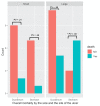A Large Stomach Ulcer Is Associated With Raised Mortality in a Cohort of Patients Who Underwent Open Repair of Perforated Peptic Ulcer: A Five-Year Follow-Up Study
- PMID: 32953306
- PMCID: PMC7491696
- DOI: 10.7759/cureus.9790
A Large Stomach Ulcer Is Associated With Raised Mortality in a Cohort of Patients Who Underwent Open Repair of Perforated Peptic Ulcer: A Five-Year Follow-Up Study
Abstract
Introduction Perforated peptic ulcer disease (PPUD) is associated with a high postoperative mortality and morbidity rates especially within the first 90 days. The size and site of the ulcer may contribute to the prognosis of PPUD. In this study, we will describe the association of size and site of PPUD with the overall mortality and in-hospital morbidities in a tertiary care university hospital. Methods A retrospective observational cohort study was conducted at King Abdulaziz University Hospital, Jeddah, Saudi Arabia. A total of 50 patients who had PPUD and underwent open exploratory laparotomy with surgical treatment were analyzed. Patients were divided into two groups: a small ulcer group when the ulcer diameter was less than equal to 1 cm and a large ulcer group when it was more than 1 cm. For the subgroup analysis, patients were categorized according to site into small duodenum, large duodenum, small stomach, and large stomach PPUD. The primary outcome was overall mortality that was measured by survival analysis and Cox regression. Secondary outcomes were intensive care unit (ICU) admission, ICU and hospital length of stay, and in-hospital mortality, which were assessed by stepwise logistics and linear regression. Results Overall mortality at 10, 30, and 90 days was 14% (95% CI: 0.06-0.27), 24% (95% CI: 0.14-0.39), and 34% (95% CI: 0.23-0.49), respectively. Saudi patients had a 72% decreased risk of overall mortality compared to non-Saudi patients (P=0.03) over the follow-up period. Overall, patients who had stomach PPUD had a 2.23-fold increased risk of overall mortality over time compared to those who had duodenum PPUD (P=0.10). Large PPUD, >1 cm, had a 3.20-fold increased risk of overall mortality over time compared to small PPUD (P=0.04). Large stomach PPUD had a 4.22-fold increased risk of overall mortality over time compared to other ulcers (P=0.01). Conclusions Large stomach PPUD is associated with increased overall mortality and morbidity. These findings indicate that patients who have a large stomach PPUD might need careful perioperative and postoperative personalized surgical plans as these patients may eventually undergo complicated surgical procedures.
Keywords: duodenum; perforated peptic ulcer; retrospective; size; stomach.
Copyright © 2020, Aljiffry et al.
Conflict of interest statement
The authors have declared that no competing interests exist.
Figures
Similar articles
-
Are Patients with Perforated Peptic Ulcers Who are Negative for Helicobacter pylori at a Greater Risk?Surg Infect (Larchmt). 2019 Sep;20(6):444-448. doi: 10.1089/sur.2018.249. Epub 2019 Apr 2. Surg Infect (Larchmt). 2019. PMID: 30939075
-
Perforated peptic ulcer disease in transferred patients is associated with significant increase in length of stay.Surg Endosc. 2024 Mar;38(3):1576-1582. doi: 10.1007/s00464-023-10600-1. Epub 2024 Jan 5. Surg Endosc. 2024. PMID: 38182799
-
Risk Factors for Gastrointestinal Leak after Perforated Peptic Ulcer Disease Operative Repair.Am Surg. 2021 Dec;87(12):1879-1885. doi: 10.1177/00031348211056263. Epub 2021 Nov 8. Am Surg. 2021. PMID: 34749511
-
Acute perforated peptic ulcer: on clinical experience in an urban tertiary hospital in south east Nigeria.Int J Surg. 2013;11(3):223-7. doi: 10.1016/j.ijsu.2013.01.015. Epub 2013 Feb 9. Int J Surg. 2013. PMID: 23403213 Review.
-
Laparoscopic versus open repair for perforated peptic ulcer: A meta analysis of randomized controlled trials.Int J Surg. 2016 Sep;33 Pt A:124-32. doi: 10.1016/j.ijsu.2016.07.077. Epub 2016 Aug 5. Int J Surg. 2016. PMID: 27504848 Review.
Cited by
-
Seasonal Variation of Presentation of Perforated Peptic Ulcer Disease: An Overview of Patient Demographics, Management and Outcomes.Cureus. 2021 Nov 16;13(11):e19618. doi: 10.7759/cureus.19618. eCollection 2021 Nov. Cureus. 2021. PMID: 34804752 Free PMC article.
References
-
- Multicentre trial of a perioperative protocol to reduce mortality in patients with peptic ulcer perforation. Møller MH, Adamsen S, Thomsen RW, Møller AM. Br J Surg. 2011;98:802–810. - PubMed
-
- A new prognostic scoring system for perforation peritonitis secondary to duodenal ulcers. Nomani AZ, Qureshi MS, Malik AK. https://www.jpma.org.pk/article-details/5741?article_id=5741 J Pak Med Assoc. 2014;64:1–10. - PubMed
LinkOut - more resources
Full Text Sources

